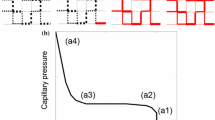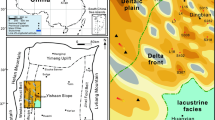Compared with the pore throat radius in tight sandstones, the mean free path of a molecule can no longer be neglected. As a result, the gas slippage effect (the Klinkenberg effect) in tight sandstones is quite significant and must be taken into account. The goal of this work was to use an analytical expression to show the effect of pore space structural parameters and temperature on the gas slippage factor, taking into account water saturation in tight sandstones. The mathematical model including water saturation was derived from fractal theory. The calculations of the gas slippage factor (the Klinkenberg constant) using the proposed model agree well with experimental data presented in the literature. We have also studied the effect of pore space structural parameters and temperature on the gas slippage factor for different water saturation values. The gas slippage factor correlates with the tortuosity fractal dimension of the pore channels for high water saturation. This distinguishes the analytical model obtained from the single-phase model neglecting the effect of water saturation.






Similar content being viewed by others
References
A. E. Scheidegger, The Physics of Flow Through Porous Media, University of Toronto Press, Toronto, Canada (1974).
K. Sampath and C. W. Keighin, “Factors affecting gas slippage in tight sandstones of Cretaceous Age in the Uinta Basin,” J. Pet. Tech. 34, 2715–2720 (1982).
J. A. Rushing, K. E. Newsham, and K. C. Van Fraassen, “Measurement of the two-phase gas slippage phenomenon and its effect on gas relative permeability in tight gas sands,” in: SPE Annual Technical Conference and Exhibition, 5-8 October 2003, Denver, Colorado; SPE 84297.
Q. Zheng and B. M. Yu, “A fractal permeability model for gas flow through dual-porosity media,” J. Appl. Phys., 111, 024316.1-024316.7 (2012).
Q. Zheng, B. Yu, Y. Duan et al., “A fractal model for gas slippage factor in porous media in the slip flow regime,” Chemical Engineering Science, 87, 209-215 (2013).
H. Loosveldt, Z. Lafhaj, and F. Skoczylas, “Experimental study of gas and liquid permeability of a mortar,” Cement and Concrete Research, 32, No. 9, 1357-1363 (2002).
S. Roy, R. Raju, H. F. Chuang, et al., “Modeling gas flow through microchannels and nanopores,” J. Appl. Phys., 93, No. 8, 4870-4879 (2003).
V. Lysenko, J. Vitiello, B. Remaki et al., “Gas permeability of porous silicon nanostructures,” Phys. Rev. E, 70, No. 1, 017301.1-017301.4 (2004).
M. Fichman and G. Hetsroni, “Viscosity and slip velocity in gas flow in microchannels,” Physics of Fluids, 17, No. 12, 123102.1-123102.5 (2005).
P. Perrier, I. A. Graur, T. Ewart et al., “Mass flow rate measurements in microtubes: from hydrodynamic to near free molecular regime,” Physics of Fluids, 23, No. 4, 042004.1-042004.11 (2011).
G. H. Tang, W. Q. Tao, and Y. L. He, “Gas slippage effect on microscale porous flow using the lattice Boltzmann method,” Phys. Rev. E, 72, No. 5, 056301.1- 056301.8 (2005).
G. H. Tang, W. Q. Tao, and Y. L. He, “Three-dimensional lattice Boltzmann model for gaseous flow in rectangular microducts and microscale porous media,” J. Appl. Phys., 97, No. 10, 104918.1-104918.8 (2005).
L. B. Loeb, The Kinetic Theory of Gases, Dover (2004).
J. G. Heid, J. J. McMahon, R. F. Nielsen et al., “Study of the permeability of rocks to homogeneous fluids,” Drilling and Production Practice, 230–244 (1950).
S. C. Jones, “A rapid accurate unsteady-state Klinkenberg permeameter,” SPE J., 12, No. 05, 383-397 (1972).
F. O. Jones and W. W. Owens, “A laboratory study of low-permeability gas sands,” Journal of Petroleum Technology, 32, No. 09, 1631-1640 (1980).
S. C. Jones, “Using the inertial coefficient B to characterize heterogeneity in reservoir rock,” in: SPE Annual Technical Conference and Exhibition, 27-30 September 1987, Dallas, Texas; SPE-16949-MS.
F. Civan, “Effective correlation of apparent gas permeability in tight porous media,” Transport in Porous Media, 82, No. 2, 375-384 (2010).
A. Koponen, M. Kataja, and J. Timonen, “Tortuous flow in porous media,” Phys. Rev. E, 54, No. 1, 406-410 (1996).
A. Koponen, M. Kataja, and J. Timonen, “Permeability and effective porosity of porous media,” Phys. Rev. E, 56, No. 3, 3319-3325 (1997).
J. Comiti and M. Renaud, “A new model for determining mean structure parameters of fixed beds from pressure drop measurements: Application to beds packed with parallelepipedal particles,” Chem. Eng. Sci., 44, No. 7, 1539-1545 (1989).
B. M. Yu and J. H. Li, “A geometry model for tortuosity of flow path in porous media,” Chin. Phys. Lett., 21, No. 8, 1569-1571 (2004).
A. J. Katz and A. H. Thompson, “Fractal sandstone pores: Implications for conductivity and pore formation,” Phys. Rev. Lett., 54, No. 12, 1325-1328 (1985).
M. I. Ozhovan, I. E. Dmitriev, and O. G. Batyukhnova, “Fractal structure of pores in clay soil,” Atomic Energy, 74, No. 3, 241-243 (1993).
J. P. Hansen and A. T. Skjeltorp, “Fractal pore space and rock permeability implications,” Phys. Rev. B: Condensed Matter, 38, No. 4, 2635-2638 (1988).
A. N. Anderson, A. B. McBratney, and E. A. FitzPatrick, “Soil mass, surface, and spectral fractal dimensions estimated from thin section photographs,” Soil Science Society of America Journal, 60, No. 4, 962-969 (1996).
B. M. Yu and P. Cheng, “A fractal permeability model for bi-dispersed porous media,” Int. J. Heat Mass Transfer, 45, No. 14, 2983-2993 (2002).
B. M. Yu, L. J. Lee, and H. Q. Cao, “A fractal in-plane permeability model for fabrics,” Polym. Compos., 23, No. 2, 201-221 (2002).
B. M. Yu and J. H. Li, “Some fractal characters of porous media,” Fractals, 9, No. 3, 365-372 (2001). 30. P. Xu and B. M. Yu, “Developing a new form of permeability and Kozeny-Carman constant for homogeneous porous media by means of fractal geometry,” Adv. Water Res., 31, No. 1, 74-81 (2008).
A. Beskok and G. E. Karniadakis, “Report: A model for flows in channels, pipes, and ducts at micro and nano scales,” Microscale Thermophysical Engineering, 3, No. 1, 43-77 (1999).
J. Cai and B. Yu, “Prediction of maximum pore size of porous media based on fractal geometry,” Fractals, 18, No. 4, 417-423 (2010).
F. A. Florence, J. Rushing, K. E. Newsham et al., “Improved permeability prediction relations for low permeability sands,” Rocky Mountain Oil & Gas Technology Symposium, 16-18 April 2007, Denver, Colorado USA; SPE-107954-MS.
Author information
Authors and Affiliations
Corresponding author
Additional information
Translated from Khimiya i Tekhnologiya Topliv i Masel, No. 3, pp. 24 – 29, May – June, 2015.
Rights and permissions
About this article
Cite this article
Lei, G., Dong, P., Mo, S. et al. Theoretical Study of the Gas Slippage Effect in the Pore Space of Tight Sandstones in the Presence of a Water Phase. Chem Technol Fuels Oils 51, 268–279 (2015). https://doi.org/10.1007/s10553-015-0601-1
Published:
Issue Date:
DOI: https://doi.org/10.1007/s10553-015-0601-1




